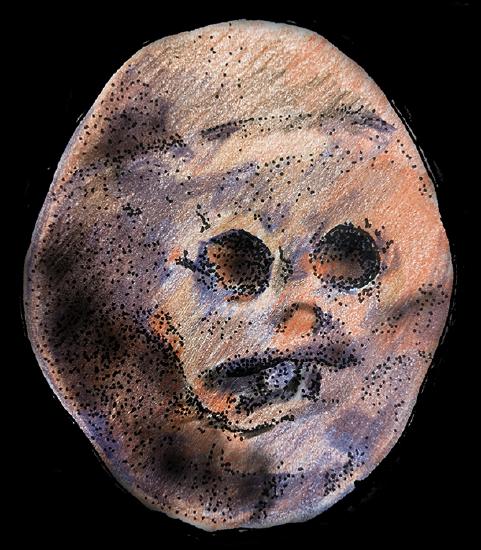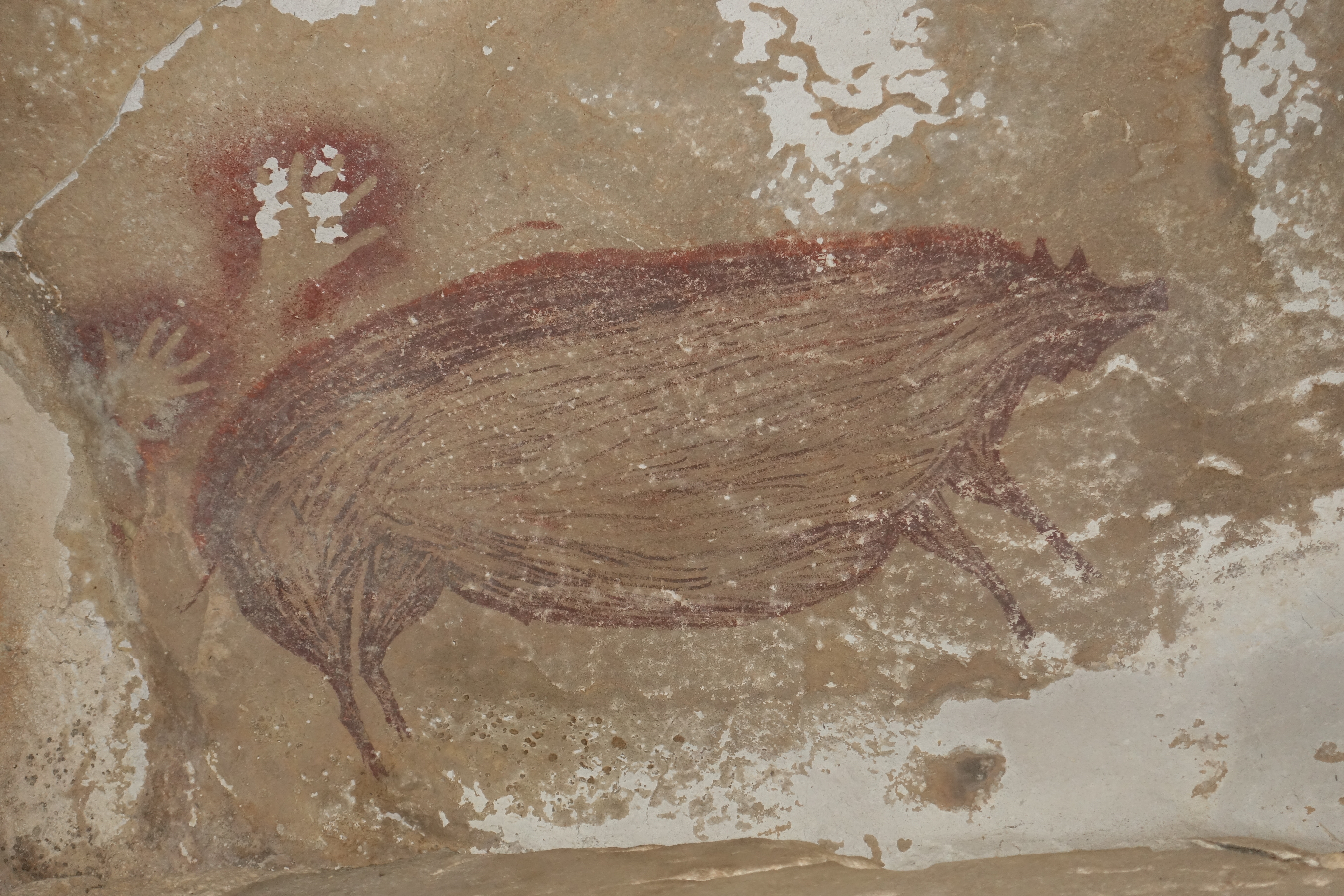5.0: Chapter Introduction
- Page ID
- 180514
Introduction: Early Origins in Africa
Humankind and the very earliest cultural and visual expressions originated in Africa more than two million years ago. Africa is also where we see the first and earliest physical evidence of the ability to recognize and create pictorial images. Specifically, in 1925 a pebble, approximately three million years old, and thus predating homo sapiens, was unearthed in a cave at Makapansgat in South Africa.

As you can see from the sketch of the Makapansgat pebble, it resembled a human face or skull, due to its natural wear, divots, and markings. The pebble was found along with the bones of an Australopithecus africanus, an early side relation in the evolutionary family of homo sapiens much like the 3.2-million-year-old ape known as "Lucy." The pebble’s location in the cave, several miles from the closest place it could have been found, suggests that these early ancestors recognized the appearance of a human head, and thus picked up, kept, and transported this naturally-occurring object. The pebble, which was not intentionally formed or modified, demonstrates recognition, but not yet representation, and it is not art.
The first examples of art in the form of purposeful and conscious abstract designs, date back 73,000 years (Pre-Paleolithic) and were found at the Blombos Cave in South Africa. (Read more about examples of such early abstract art in Origins of Rock Art in Africa.) The first examples of art in the form of pictorial images date back to the Paleolithic period (40,000-30,000 BCE). One of these recently discovered pictorial images is not from Africa, where humankind originated, nor from Europe, where the most documented examples are from, but is from Sulawesi, Indonesia, and showcases the most common theme in Stone Age art: figurative depictions of animals.
This discovery, which dates back 43,900 years, is believed to be the oldest documented depiction of the animal world. Found in Leang Tedongnge cave and made with red ochre pigment, the painting depicts a sprawling and complex hunting scene including a nearly pristine depiction of a Sulawesi warty pig, a group of therianthropes (mythical beings or deities which are part human and part animal), a type of buffalo called an anoa, and the outlines of human hands—likely those of the artist(s). (Read more about this discovery at "Is this cave painting humanity’s oldest story?")


Similarly, another recent discovery of ancient figurative cave paintings is in Kalimantan, Borneo. These cave paintings date back to approximately 40,000 years ago with additional phases of paintings dating back to about 20,000 years ago. There is a transition between the two phases of cave paintings, demonstrating an artistic shift from depicting the animal world to depicting the human world—something that is also seen and documented in different phases of cave paintings in Europe as well. Through these findings in Southeast Asia, archeologists are able to widen the scope and our understanding of Paleolithic art.
Additionally and perhaps most importantly, one of the many exciting things about the discoveries in Sulawesi and Kalimantan is that we as humans are continuing to learn our own history and origin stories through such findings. The fact is that before there are human records telling people’s stories, the whole picture is not fully clear. But through archaeology and art history, humans continue to learn—and through such discoveries, the understanding of the human story changes too.
Historiography (Writing History)
Although humankind’s origins are rooted in Africa, history has not always been written this way, nor has it acknowledged this truth. As referenced in the introduction to this textbook, art history as a discipline was invented in Europe, so although the oldest art and people are from Africa, much more documentation and research on early humans was conducted in Europe, as explored below. However, exciting new discoveries are still happening, such as with the caves in Sulawesi and Borneo.
Art Historical Periods and Naming
This chapter focuses on three art historical periods: Paleolithic, Mesolithic, and Neolithic. Sometimes these periods are also named for regions, as is the case for periods in the next chapter, including Sumerian, Akkadian, Babylonian, and more. As you study this material, pay attention to the distinguishing characteristics of each period, as well as which works of art and architecture fit into each.
Terminology: Problems with “Prehistoric”
The Stone Age era is sometimes generally referred to as “Prehistoric,” but that term is problematic. It was first used in mid-nineteenth-century Britain, when scholars ranked cultures on a single Eurocentric continuum from “savage” to “civilized.” This continuum is part of a white, European worldview that held the ideology—and justification—that so-called “savages” needed to be pacified and ruled. “Prehistory” referred to societies that had not developed writing, and the Eurocentrism of this ranking becomes clear when we realize that British archaeologists deemed China’s highly-developed culture as uncivilized because their written language used characters that can represent concepts or sounds, and not an alphabetic script. Additionally, highly advanced societies that prize oral literacy and oral history over writing would not have been considered civilized either. Archaeologists, anthropologists, and art historians have since recognized that to understand a culture, they have to consider it on its own terms, rather than measuring it by a yardstick from their own culture.
Stone Age Art and Eurocentrism
Since the first modern scholars to recognize the Stone Age were Europeans, it is not surprising that they found their examples in Europe. Additionally, once one archaeological site became famous, people began to recognize other sites in neighboring areas and regions.
But there are more troubling reasons for the Eurocentrism of the history of Paleolithic art:
- Early in the 20th century, when the first cave paintings were recognized as being very old, many European scholars still believed that Europe was the most advanced part of the world, so they assumed that the oldest art would be found there.
- Europeans took objects from around the world back to Europe, meaning that if you wanted to study these objects, you had to work within the European system of understanding them.
- European specialists made the problematic argument that cave paintings found in Namibia could not be Paleolithic because they were too advanced for Africans to have made. This idea is rooted in the racist belief that Africans were inferior and uncivilized and hence could not have made these cave paintings. The paintings’ very naturalism suggested to Europeans that they were older than they actually were, because European tradition since the Renaissance had held naturalism—falsely—to be superior to abstraction. For a much later example of Europeans’ disbelief that Africans were capable of producing naturalistic and/or highly advanced art, read about the brass Head of a Ruler from Ife, and who Europeans initially believed must have created it!
We will continue to see examples of Eurocentrism in art history as we move through subsequent chapters. As we discussed in the introduction to this textbook, however, our goal is to help you identify it when you see it, and to include sites and objects that help to give a more balanced and global understanding of artistic creation and cultural production in the places and time periods that we study.
Chapter Overview
This chapter focuses on the very earliest art during a period known generally as the Stone Age (so-named since these societies used tools made of stone). This chapter examines Paleolithic, Mesolithic, and Neolithic sites and objects in Africa, Europe, and Southeast Asia; considers the distinguishing features of these different eras; and explores some of the paintings and sculptures that give us a glimpse into the lives of our earliest ancestors.
Stone Age Periods
Archaeologists divide the Stone Age into three stages, based on where people got their food:
- Paleolithic (from the Greek for old and stone) or Old Stone Age: 40,000 BCE–10,000 BCE; people gather wild plants and hunt animals
- Mesolithic (from the Greek for middle and stone) or Middle Stone Age: 10,000 BCE–8,000 BCE; people begin to plant food crops and/or live with animals
- Neolithic (from the Greek for new and stone) or New Stone Age: 8,000 BCE–3,000 BCE; people farm and raise animals for food
Neolithic settlements are indicated by the remains of permanent buildings, crop storage, and domesticated animals. Paleolithic sites lack any of these, and have their own distinctive stone tools. A Mesolithic site might have just one of the Neolithic features, while clearly still having belonged to hunter-gatherers. It is also important to note that the transition to the Neolithic period did not occur at the same time everywhere.
During these periods, humans created a wide variety of diverse and representational art, from small and monumental paintings on cave walls, to portable items like necklaces made with stones and shells, to figural and sculptural forms made from clay, stone, and ivory.
Objects overview
Some of the exciting works of art that this chapter will cover detail a wide range of Stone Age media including cave paintings, sculptures, and archaeological sites, including:
- the new discoveries of the oldest cave art found in Sulawesi, Indonesia
- the Woman of Willendorf, a 25,000 year-old sculptural carving of a woman
- the Halls of Bulls in Lascaux, France (once believed to be the earliest surviving example of artistic expression)
- the Apollo 11 Cave Stones, one of the oldest examples of mobile art
- the Biblical oasis of Jericho and the pre-pottery Neolithic examples of plastered skulls made to resemble living, human heads
- Çatalhöyük, the Neolithic proto-city in Turkey
- pictorial images of a running, horned woman found in Tassili n’Ajjer, Algeria
In this chapter, we will explore the differences between the Paleolithic, Mesolithic, and Neolithic ages, using the art of these times as our lens.
By the time you finish reading this chapter on the oldest art, you should be able to:
- Identify the origins of humankind
- Explain the differences between Paleolithic, Mesolithic, and Neolithic societies
- Relate those differences to what you see in Paleolithic, Mesolithic, and Neolithic art and architecture
- Identify differences between the periods and relate them to a result of social and environmental changes
- Recognize earliest visual expressions that give glimpses into lives of our earliest ancestors
- Identify the role of human and animal figures in Paleolithic, Mesolithic, and Neolithic art
- Discuss origins of creativity, representation, and stylistic innovation in the Paleolithic period, worldwide
- Describe the materials and techniques of art in the Paleolithic, Mesolithic, and Neolithic periods
- Recognize that much of what we know about the Stone Age is due to sheer accidents of discovery, so there is much that we still do not know about the oldest art
Want to know more?
Here are some additional resources you can explore to further your understanding of the art discussed in this chapter.
- Reuters, "SA Cave Pebble Outshines Treasures at British Museum"
- Encyclopedia Britannica, "Cave Painting"
- British Museum, "Facing the Past: the Jericho Skull"
- Science Advances, “Oldest Cave Art Found in Sulawesi”
- Nature, “Is this cave painting humanity’s oldest story?”
- Met Museum, "Lascaux Caves"
- Griffith University, Figurative Cave Art in Borneo [Video]

